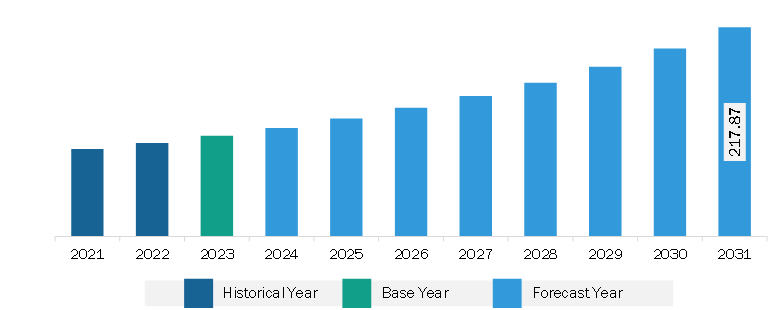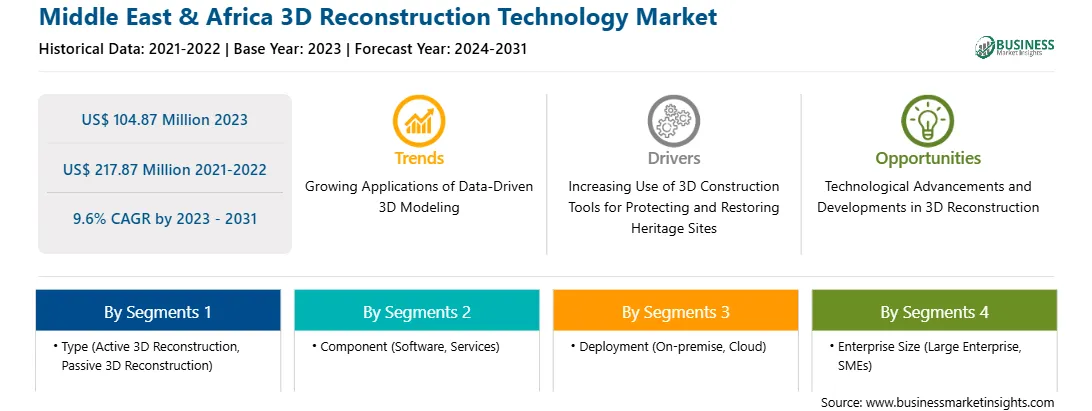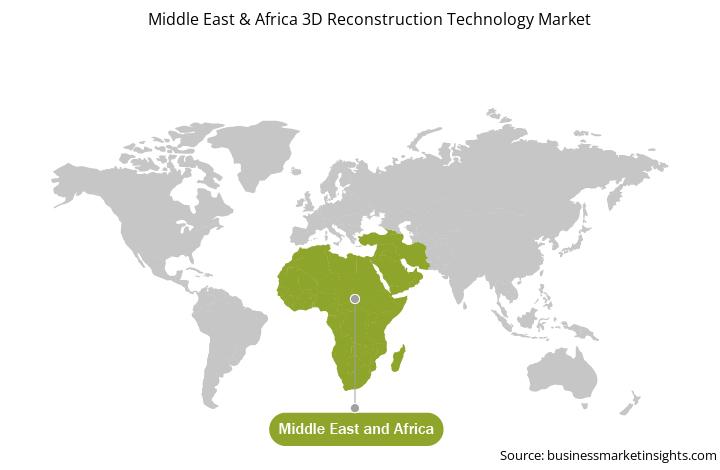Middle East & Africa 3D Reconstruction Technology Market
No. of Pages: 89 | Report Code: BMIRE00031001 | Category: Technology, Media and Telecommunications
No. of Pages: 89 | Report Code: BMIRE00031001 | Category: Technology, Media and Telecommunications
The Middle East & Africa 3D reconstruction technology market was valued at US$ 104.87 million in 2023 and is expected to reach US$ 217.87 million by 2031; it is estimated to record a CAGR of 9.6% from 2023 to 2031.
Growing Applications of Data-Driven 3D Modelling Bolster Middle East & Africa 3D Reconstruction Technology Market
Data-driven 3D modeling or 3D reconstruction is a growing field in computer vision, with applications in AR, VR, media and entertainment, healthcare, construction, aerospace, defense, and education. It enables the synthesis of 3D data from 2D images or videos, providing a better understanding of the environment and enhancing immersive experiences. Data-driven 3D modeling is a valuable tool utilized in the aerospace and defense sectors for various applications, including simulation, training, and virtual prototyping. This technology makes use of data to create accurate and detailed 3D models that can simulate real-world scenarios and environments. In the aerospace industry, data-driven 3D modeling plays a crucial role in simulating aircraft performance, aerodynamics, and structural integrity. It enables engineers to conduct virtual tests and simulations, allowing them to analyze and optimize designs before physical prototypes are built. This helps reduce costs, improve efficiency, and ensure safety in developing new aircraft and aerospace systems. For defense applications, data-driven 3D modeling enables the creation of virtual environments for training purposes. Military personnel can immerse themselves in realistic simulations that replicate combat scenarios, equipment operation, and tactical training. This technology provides a safe and cost-effective way to train soldiers, pilots, and other defense personnel, enhancing their skills and preparedness. Data-driven 3D modeling facilitates virtual prototyping, allowing engineers to visualize and evaluate designs before manufacturing. This helps identify potential issues, optimize performance, and reduce the time and cost associated with physical prototyping. By using accurate and detailed 3D models, engineers can make informed decisions and iterate designs more efficiently. Therefore, the growing application of data-driven 3D modeling in different sectors is anticipated to be a key trend in the 3D reconstruction technology market during the forecast period.

Strategic insights for the Middle East & Africa 3D Reconstruction Technology provides data-driven analysis of the industry landscape, including current trends, key players, and regional nuances. These insights offer actionable recommendations, enabling readers to differentiate themselves from competitors by identifying untapped segments or developing unique value propositions. Leveraging data analytics, these insights help industry players anticipate the market shifts, whether investors, manufacturers, or other stakeholders. A future-oriented perspective is essential, helping stakeholders anticipate market shifts and position themselves for long-term success in this dynamic region. Ultimately, effective strategic insights empower readers to make informed decisions that drive profitability and achieve their business objectives within the market.

| Report Attribute | Details |
|---|---|
| Market size in 2023 | US$ 104.87 Million |
| Market Size by 2031 | US$ 217.87 Million |
| Global CAGR (2023 - 2031) | 9.6% |
| Historical Data | 2021-2022 |
| Forecast period | 2024-2031 |
| Segments Covered |
By Type
|
| Regions and Countries Covered | Middle East and Africa
|
| Market leaders and key company profiles |
The geographic scope of the Middle East & Africa 3D Reconstruction Technology refers to the specific areas in which a business operates and competes. Understanding local distinctions, such as diverse consumer preferences (e.g., demand for specific plug types or battery backup durations), varying economic conditions, and regulatory environments, is crucial for tailoring strategies to specific markets. Businesses can expand their reach by identifying underserved areas or adapting their offerings to meet local demands. A clear market focus allows for more effective resource allocation, targeted marketing campaigns, and better positioning against local competitors, ultimately driving growth in those targeted areas.

The Middle East & Africa 3D Reconstruction Technology Market is valued at US$ 104.87 Million in 2023, it is projected to reach US$ 217.87 Million by 2031.
As per our report Middle East & Africa 3D Reconstruction Technology Market, the market size is valued at US$ 104.87 Million in 2023, projecting it to reach US$ 217.87 Million by 2031. This translates to a CAGR of approximately 9.6% during the forecast period.
The Middle East & Africa 3D Reconstruction Technology Market report typically cover these key segments-
The historic period, base year, and forecast period can vary slightly depending on the specific market research report. However, for the Middle East & Africa 3D Reconstruction Technology Market report:
The Middle East & Africa 3D Reconstruction Technology Market is populated by several key players, each contributing to its growth and innovation. Some of the major players include:
The Middle East & Africa 3D Reconstruction Technology Market report is valuable for diverse stakeholders, including:
Essentially, anyone involved in or considering involvement in the Middle East & Africa 3D Reconstruction Technology Market value chain can benefit from the information contained in a comprehensive market report.